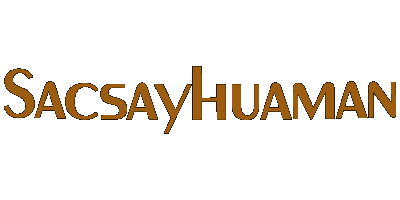


Sacsayhuaman is one of the most
impressive Inca temples in the Cusco City and definitely one of the
most beautiful places of Peru. It is located in the northern zone of
the Cusco, to 2 Kilometers of the Downtown of the city. The entire
complex covers around 3093 hectares. Originally, Cusco was designed
with the shape of Puma (wildcat) and the Sacsayhuaman Temple was
constructed to be the head of the Puma.
The name of the temple is a composed
Quechua word (the language of the Inca Empire), which derives from
“Saqsay” that means “to satisfy” and the word “Waman” that means
“falcon”; then Sacsayhuaman would mean satisfied falcon.
Nevertheless, another theory proposes that the correct translation
of the name is speckled falcon.
Like most Inca structures, Sacsayhuaman
was constructed using huge stones, which fit perfectly so that
neither a sheet of paper could pass between them. The Sacsayhuaman
Temple has a very special design with walls in zigzag, because of
this uncommon design similar to some castles in Europe, Spanish
invaders believed that Sacsayhuaman was a fortress. Nevertheless,
the Sacsayhuaman Temple was dedicated to the Andean God Illapa (the
Ray or Lightning), which was very important to the agriculture
rituals; this deity is the true reason of the shape of the
Sacsayhuaman Temple.

The main zone of the temple is composed
by three zigzagging ramparts, built with giant pieces of stone,
which can reach until 8 meters high and 361 tons weight. Many of the
stones used in the temple were brought to Sacsayhuaman from a
quarry, located around 35 Kilometers from the temple. The three
ramparts represent also the Andean Cosmology, which was composed by
three universes: Hanaq Pacha (this is the world where gods live),
Kay Pacha (the reality where we live) and the Uhu Pacha (the
underworld).
The amazing stones stretch in a zigzag
pattern for almost 400 meters. The stones support earthworks on top
of which, there are more structures. In front to the three ramparts,
there is a flat green plaza (square), which was used with ceremonial
purposes. This square is presided by a magnificent throne carved
into one piece of granite, which was used by the Inca (the King) in
the ceremonies.
The complex has also an enigmatic system
of underground passages known as “Chincanas”; it believes that these
Chincanas connected the Temple of Sacsayhuaman with other temples
and palaces and temples in Cusco, such as the Qoricancha (Sun’s
Temple), the Cathedral, the Santa Catalina Convent, amongst other.
There are some satellite images that sustain this theory.

The complex has also a zone with large
stone slides, which are used now as an entertainment place.
Originally, there had also three turrets Muyucmarca, Sallacmarca and
Paucarmarca, the most famous of them, Muyucmarca was a cylindrical
turret of 22 meters diameter and 4 levels. During the Manco Inca’s
revolution, one of his captains, named Cahuide decided to throw
oneself into the void from the turret, preferring to die before
falling into the hands of the European invaders. Unfortunately this
turret was destroyed and currently, it can see only the remains its
base.
Besides, Sacsayhuaman is surrounded by a
great number of beautiful Inca temples like Puca Pucara, Q’enko or
the amazing water fonts of Tambomachay. If you want to visit
Sacsayhuaman there are many bus lines, taxis and private travel
agencies available in Cusco. The temple is only to 15 minutes by car
from the Downtown of the city. Sacsayhuaman is one of the places
that it must definitely visit if you are in South America.
Archeologists believe that the construction of Sacsayhuaman began in the second half of the XV century. The temple was built by order of the Inca Pachakuteq, who was the greatest king of the Great Inca Empire. Nevertheless, the construction of the temple was continued after the Pachakuteq’s death by his son Túpac Yupanqui and by his grandson Huayna Capac. Archeologists calculates that the construction of Sacsayhuaman lasted around 50 years and 20 000 men were used to built this monumental work. According to the Cusqueño (born in Cusco) writer Inca Garcilazo de la Vega, the construction of the temple was headed successively by four important Inca builders: Apu Huallpa Rimachi, Inca Maricanchi, Acahauana Inca and Callacunchuy. Nevertheless, there are not registers that confirm this asseveration.
During the
Spanish invasion in 1536, Manco Inca one of the first men that
fought against the Spanish invaders in the New World, use the
Sacsayhuaman Temple as base to combat against Spaniards; therefore,
Spaniards believed that the temple was a fortress. Unfortunately,
Manco Inca lost the battle and decided to move the capital of the
Empire to Vilcabamba, which was the home of the Vilcabamba Dynasty,
the last Inca Panaqa (Royal family) of Peru. After the defeat of
Manco Inca, a great part of Sacsayhuaman was dismantled and many
beautiful stones of the temple were used to build new colonial
buildings in Cusco. During the colonial age, which lasted 300 years
the temple was abandoned. Only in the XX century the people of Cusco
revalued the greatness of their glorious past and decided to
retrieve the sacred Temple of Sacsayhuaman.
Today Sacsayhuaman is one of the main
archeological sites of Cusco and South America. Besides, the temple
is used every year to celebrate on June 24, the famous Inti Raymi
(Fest of the Sun). This fest is celebrated since the Inca time in
the winter’s solstice. It is the most important celebration in Cusco
and one of the main celebrations of the country. In this fest, local
actors stage the ritual Inca worship in honor to the God Sun. The
local actors play and dance, using typical and colorful costumes,
repeating the tradition of their ancestors.
In the last years several investigations
has been made in Sacsayhuaman and many other important archeological
discoveries have been done. In March 2008, a group of scientists of
the INC (National Culture Institute of Peru) found the remains of a
new temple in the Sacsayhuaman area, as well as a very complex
hydraulic net. They found also several remains of funeral ceremonies
and a great quantity of ceramics and metal items, which belonged to
the Inca civilization. These discoveries are allowing to the
archeologists to build a best picture of the real role of
Sacsayhuaman in the Inca time.

Currently, Sacsayhuaman is used also by many local and foreign
people to do yoga, tai chi and meditate, taking advantage of the
peaceful and mystical atmosphere of the temple. Sacsayhuaman is one
of the most wonderful places of Peru and America.